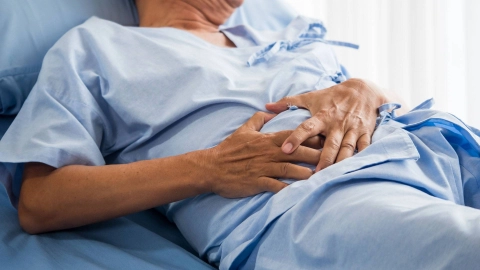Conditions EHEC infections
ICD codes: A04.3 D59.3 What are ICD codes?
Infection with EHEC bacteria can cause severe diarrhea. In most cases it is caused by consuming contaminated foods or close contact with animals which naturally carry EHEC in their digestive tract. In severe cases complications such as acute kidney failure may occur.
At a glance
- EHEC stands for enterohemorrhagic Escherichia coli. These are bacteria that are found mainly in the digestive tracts of ruminants such as cows and sheep.
- In human beings, EHEC bacteria can cause diarrhea as well as serious complications such as acute kidney failure.
- Most infections with EHEC come from contaminated food or contact with objects or animals with traces of animal feces on them.
- One potential serious complication is hemolytic uremic syndrome (HUS). This occurs particularly in small children.
- Infections can be prevented by careful hand hygiene and hygiene in the kitchen.
Note: The information in this article cannot and should not replace a medical consultation and must not be used for self-diagnosis or treatment.

What is an EHEC infection?
EHEC is short for enterohemorrhagic Escherichia coli. This is a highly disease-causing group of coli bacteria.
Some coli bacteria occur naturally in the human digestive tract. EHEC bacteria, however, occur naturally in the digestive tract of ruminants such as cows, sheep or deer. EHEC can produce toxic substances (toxins) that can cause severe illness in human beings.
EHEC infections can go unnoticed but may also be accompanied by severe diarrhea. One potential but rare complication is hemolytic uremic syndrome (HUS). This can sometimes cause acute kidney failure. HUS is normally only temporary and usually abates later. Late complications may sometimes occur.
What are the symptoms of EHEC infections?
Infection with EHEC can be entirely asymptomatic but may also be very severe and cause complications.
Initial symptoms generally appear between 2 to 10 days after infection. Most conditions are characterized by watery diarrhea with nausea, vomiting, abdominal pain and in rare cases fever.
Severe cases
In 10 to 20 out of 100 people affected the watery diarrhea becomes bloody diarrhea with cramping abdominal pain and sometimes fever. Babies, small children, older people and people with immune deficiency are particularly affected.
Cases with complications
5 to 10 out of 100 of the people affected develop hemolytic uremic syndrome (HUS) 5 to 12 days after the first bouts of diarrhea. Children are particularly affected. HUS causes destruction of red blood cells and acute renal failure. This causes a buildup of toxic metabolic products in the blood (uremia). The platelets are also destroyed, which impairs blood clotting.
What causes an EHEC infection?
EHEC infections are caused by infection with enterohemorrhagic Escherichia coli (EHEC) bacteria. The word “enterohemorrhagic” indicates that the severe inflammation of the digestive tract causes bloody diarrhea.
EHEC is a strain of coli bacteria, which produce certain toxic substances (toxins). These are referred to as Shiga toxins or verotoxins. Toxin-producing EHEC bacteria may belong to a number of sub-groups. The sub-group that causes most severe conditions in human beings globally is O157.
EHEC bacteria occur naturally in the digestive tract of ruminants such as cows, goats, sheep or deer. They excrete the bacteria with their feces.
Human beings become infected with EHEC when they come into contact with the feces of these animals and the bacteria pass from their hands to their mouths.
Indirect infections are also possible, for example by eating food contaminated with EHEC bacteria or touching contaminated objects. This can also occur when stroking ruminant’s fur, or handling raw meat. Ruminants do not become ill if they have EHEC bacteria in their digestive tract. So even healthy animals may also be infectious.
Common sources of infection are contaminated water, for example from a swimming lake, or drinking unpasteurized milk and eating raw sausages or meat that has not been cooked through. People may also pick up infections from green leafy vegetables, such as lettuce, spinach or sprouts. A very small number of these bacteria is sufficient to cause an infection.
People can also pass on the infection if they have diarrhea, particularly to others living in the same household. EHEC bacteria are highly infectious and can be excreted with feces for days or weeks, even after the symptoms have cleared up. They can continue to be excreted for over a month, particularly in children. However the risk of infection falls sharply over time.
How common are EHEC infections?
EHEC bacterial infections occur all over the world. It is impossible to determine the exact number of EHEC infections as the pathogens are not reliably detected in all cases of diarrheal diseases.
1,370 cases of EHEC infections were reported in Germany in 2020. Children under 5 years of age, particularly one-year-olds, are most frequently affected. There were two deaths as a result of EHEC. These occurred in the older population.
What is the outlook for an EHEC infection?
EHEC infections range from mild to extremely severe. However, people can recover without health effects from even severe cases of bloody diarrhea caused by an EHEC infection. Even severe cases with hemolytic uremic syndrome (HUS) can be effectively treated.
Children only have to undergo permanent dialysis (cleaning of the blood) in rare cases. However late complications are a possibility.
The toxins produced by the EHEC bacteria particularly attack the walls of small blood vessels that are found all around the body. So HUS is a multi-systemic condition that affects multiple organs at the same time.
The first and most severe manifestations of the condition occur in the kidneys and gastrointestinal tract. However, it can also affect the brain and the nerves, the pancreas and the skeletal and heart muscles.
This can sometimes lead to neurological problems or pancreatic diseases such as type 2 diabetes. Children who have recovered from hemolytic uremic syndrome are more susceptible to kidney diseases afterwards. This is often associated with high blood pressure.
How can an EHEC infection be prevented?
EHEC bacteria are relatively stable and can survive in the environment for a long time. Just a small amount of bacteria is enough to cause the condition.
The following rules on hygiene help to prevent infection:
- regular handwashing with soap after going to the toilet, before eating and before preparing meals
- thorough cleaning of hands after contact with animals in a petting zoo or farm: for small children in particular, before they put their fingers in their mouth or eat something
- follow kitchen and food hygiene rules closely
- if possible, avoiding close contact with people who are ill. This is particularly the case for siblings.
Special rules apply to those who are infected and their contacts:
- If possible, use a separate toilet. Hygiene is particularly important when going to the toilet.
- Wash hands thoroughly after changing diapers of infected children.
- People affected who are from the same household should not enter community facilities such as kindergartens or schools. Doctors providing treatment must decide when they can return to visit or work in a community facility.
- People who prepare and process food or work in the kitchen of a community facility must not go to work until they have stopped excreting the EHEC pathogens in their stool.
For more information on preventing EHEC infections, see the consumer tips provided by the Federal Institute for Risk Assessment (BfR).
What are the symptoms of an EHEC infection?
Any diarrheal disease can be caused by EHEC bacteria.
However there are certain indications that prompt doctors to determine the pathogen more precisely, for instance where:
- children under 6 with diarrhea require hospital treatment
- the diarrhea is bloody, or a colonoscopy reveals a bloody inflammation of the mucosa lining of the digestive tract
- diarrhea occurs in people who process foods or work in kitchens or canteens
- hemolytic uremic syndrome (HUS) is present
- people have had contact with people with HUS
- children have acute kidney failure
In these cases a stool sample is sent to the laboratory to be tested for EHEC and the toxins produced by EHEC. There are also specific antibodies that can be detected in the blood of people with HUS.
How is an EHEC infection treated?
Treatment of an EHEC infection is generally restricted to supporting vital bodily functions. The most important factors are ensuring sufficient mineral and fluid intake. Intravenous fluid replacement can reduce kidney damage if applied at an early stage. This infusion therapy can only be provided in a hospital.
Where complications such as hemolytic uremic syndrome occur, doctors will start by administering medication to stimulate excretion via the kidneys. If the kidneys have already stopped functioning, artificial cleaning of the blood (dialysis) is required. Patients may sometimes also need blood transfusions to replace red blood cells, platelets or plasma.
Important: Antibiotics are not normally used to treat EHEC infections since they prolong bacterial excretion and can stimulate the bacteria to produce even more toxins. This also increases the risk of developing hemolytic uremic syndrome.
- Gesellschaft für Pädiatrische Nephrologie e.V. (GPN), Deutsche Gesellschaft für Kinder- und Jugendmedizin e.V. (DGKJ). Hämolytisch-urämisches Syndrom im Kindesalter. S2k-Leitlinie. AWMF-Registernummer 166-200. 11.2016.
- Rawish F, Muhammad A. Enterohemorrhagic Escherichia Coli. [Updated July 25, 2021]. In: StatPearls [Internet]. Treasure Island (FL): StatPearls Publishing; 2022 Jan-. Aufgerufen am 10.02.2022.
- Robert-Koch-Institut (RKI). Infektionsepidemiologisches Jahrbuch meldepflichtiger Krankheiten für 2020. Datenstand 1. März 2021. Aufgerufen am 10.02.2022.
- Robert Koch-Institut (RKI). RKI-Ratgeber: EHEC-Erkrankung. Zuletzt aktualisiert: November 2019. Aufgerufen am 10.02.2022.
- Rosales A, Hofer J, Zimmerhackl LB et al. German-Austrian HUS Study Group. Need for Long-term Follow-up in Enterohemorrhagic Escherichia coli-Associated Hemolytic Uremic Syndrome Due to Late-Emerging Sequelae. Clin Infect Dis. 2012 May;54(10):1413-21. doi: 10.1093/cid/cis196. Epub 2012 Mar 12. PMID: 22412065.
Reviewed by the National Consultant Laboratory for Hemolytic Uremic Syndrome (HUS).
As at:





